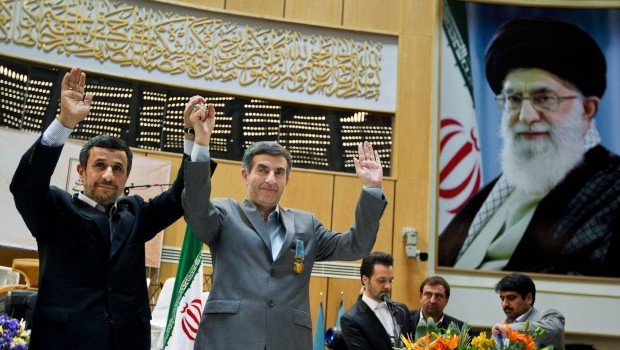
In this Sunday, March 10, 2013 photo, Iranian President Mahmoud Ahmadinejad, left, holds hands with chief of staff and preferred presidential candidate Esfandiar Rahim Mashaei, during a press conference in Tehran, Iran. A poster with the portrait of Iranian Supreme Leader Ayatollah Ali Khamenei is seen at right. (AP Photo/Fars News Agency, Mohammad Hassanzadeh)
According to the poll, former reformist president Seyyed Mohammad Khatami is the most popular, but only 20% of respondents reported intending to vote for him. Rahim Mashaei, the candidate supported by current president Mahmoud Ahmadinejad, came in eighth place, with only 4% of respondents planning to vote for him. Another former president, Hashemi Rafsanjani, came in second place, with 15% of likely voters intending to cast their ballots for him.
There is no evidence that the poll is genuine, much less that was conducted according to credible methodology. However, the fact that both the conservatives and Ahmadinejad’s faction, the Alliance of Builders of Islamic Iran, have not yet declared their final candidates might suggest some traces of truth in the poll’s findings, especially regarding the level of uncertainty among the electorate.
Predicting the outcomes of Iran’s June presidential election is challenging, given the uncertainty surrounding potential candidates and their respective factions.
Ahmadinejad’s performance over the last eight years has made the map of Iranian politics far more complex and obscure for foreign observers and insiders alike.
His unpredictability and self-styled presidency seem to have fundamentally challenged the structure of power enshrined in Iran’s constitution. In the middle of Ahmadinejad’s second presidential term, a number of MPs raised the possibility of revising the constitution in order to replace the position of president with a prime minister. In their view, having a prime minister would fit much better with the overall hierarchy of the Islamic Republic, given the Supreme Leader’s ultimate power.
Ahmadinejad’s election in 2005 amazed many observers, especially considering he was a newcomer rivaling the incumbent Ayatollah Hashemi Rafsanjani.
Many analysts have since tried to explain his success in challenging Rafsanjani. While some observers argue that the 2005 elections where engineered by a powerful conservative faction, rebranded as principalists, many simply point to the apathy and disappointment of Iran’s middle class with the performance of the reformist faction under president Khatami.
However, what became clear after the 2005 election is that the traditional voting trends in Iran have changed. In the absence of established and transparent political parties, short-lived political factions are still emerging and becoming active so as to appease the electorate and ensure the required participation.
An integral part of this process is the steep increase of potential and self-declared candidates who have publicly announced their intention to run for office. Many of them are members of known political groups and are politically very conservative. This makes their willingness to be nominated for the presidency more surprising, as their chances of winning the office are minimal. Perhaps their goal for their candidacy is to promote debate and prepare the people for a real competition to take place in the final stages of this election.
